New Garmin: Fantom radomes & Panoptix thru-hull FLS, plus radios & “budget” MFDs
Were you hoping that Garmin would bring its Fantom solid-state radar technology down to radome size, including the Doppler-assisted target motion highlighting they call MotionScope? How about two sizes, 18 and 24 inch? Or maybe you’re a Garmin owning cruiser jealous of Simrad or B&G users with ForwardScan forward looking sonar? That’s also taken care of, sort of. And these are just two highlights of all the new products Garmin announced today, many of which will ship soon…
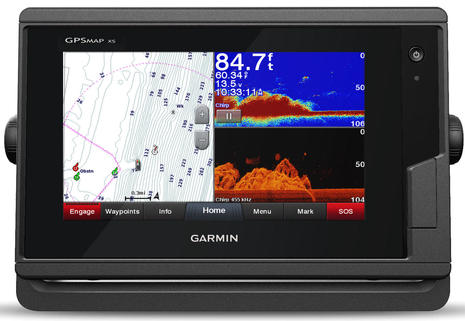 Let’s start with the new GPSMap multifunction display series. The 7-inch touchscreen MFD above is one of four new 7×2 models and there will also be four 9×2 models, all now online here. Here’s how they differ: The top-end 742xs retails at $1,000 with preloaded U.S., Canadian, and Bahamas charts, plus U.S. lake maps and also built-in traditional/CHIRP fishfinding and CHIRP ClearVu (the bottom right window above, called DownView or DownScan by other manufacturers and subject to a long-term patent dispute). For $100 less you can get a 722xs with just a worldwide basemap or a 742 with no sonar, and, finally, the $800 GPSMap 722 has neither sonar nor detailed charts.
Let’s start with the new GPSMap multifunction display series. The 7-inch touchscreen MFD above is one of four new 7×2 models and there will also be four 9×2 models, all now online here. Here’s how they differ: The top-end 742xs retails at $1,000 with preloaded U.S., Canadian, and Bahamas charts, plus U.S. lake maps and also built-in traditional/CHIRP fishfinding and CHIRP ClearVu (the bottom right window above, called DownView or DownScan by other manufacturers and subject to a long-term patent dispute). For $100 less you can get a 722xs with just a worldwide basemap or a 742 with no sonar, and, finally, the $800 GPSMap 722 has neither sonar nor detailed charts.
The 9-inch touchscreen is a new size for Garmin and the four 9×2 models follow the same naming conventions and pricing increments, with the GPSMap 922 at $1,100 and the top-end 942xs at $1,300. Feature wise, I don’t see much that hasn’t already been introduced in Garmin’s 76xx/74xx models and high-end 86xx/84xx series. But I think it is a big deal to have all those features at much lower prices (still not cheap, but the press release’s, “designed for the budget-conscious customer who desires premium features,” seems fair). I’ll discuss the features further below, but in the meantime, can anyone find a significant difference between the $1,100 GPSMap 7407 and the new $800 722 aside from the J1939 engine port?
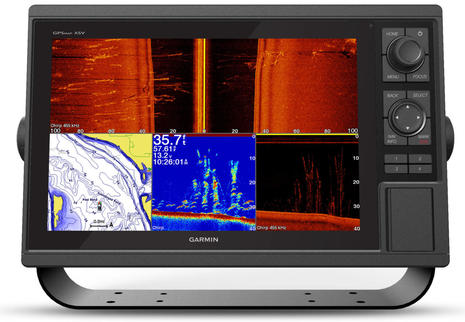 The new not-touchscreen GPSMap 10×2 and 12×2 series follow the same four-model-per-screen-size pattern, except that sonar models like the 12x2xsv above also include SideVu processing. The 10-inch models range from $1,700 to $2,300, and the 12’s from $2,400 to $3,000. Personal opinion: if the newly designed “keyed interface” with separate knob and cursor controls works as well as it looks, I’ll be lobbying Garmin to put it into a remote keypad alternative to the big GRID or the Wireless Remote.
The new not-touchscreen GPSMap 10×2 and 12×2 series follow the same four-model-per-screen-size pattern, except that sonar models like the 12x2xsv above also include SideVu processing. The 10-inch models range from $1,700 to $2,300, and the 12’s from $2,400 to $3,000. Personal opinion: if the newly designed “keyed interface” with separate knob and cursor controls works as well as it looks, I’ll be lobbying Garmin to put it into a remote keypad alternative to the big GRID or the Wireless Remote.
 While this screen shows the new Garmin Fantom 24 radome at work, it was not taken with one the new MFDs. But it could have been because the 7×2, 9×2,10×2, and 12×2 series all support newer Garmin features like that Virb camera window (I so like) plus the built-in ANT connectivity to goodies like the gWind Wireless 2 sensor and the Quatix 3 watch (that have both also tested well for me and await writeup).
While this screen shows the new Garmin Fantom 24 radome at work, it was not taken with one the new MFDs. But it could have been because the 7×2, 9×2,10×2, and 12×2 series all support newer Garmin features like that Virb camera window (I so like) plus the built-in ANT connectivity to goodies like the gWind Wireless 2 sensor and the Quatix 3 watch (that have both also tested well for me and await writeup).
But the change runs deeper than surface features. Over the last couple of years Garmin seems to have changed MFD software platforms and even how it does some wireless connections like ANT. The results range from interface routines that work differently between different model networked displays to new accessory products that don’t work with fairly recent MFDs, or vice versa. For instance, I was surprised to learn that the RF Wireless Remote Control that had worked with many past Garmin MFDs had been replaced by the very similar Wireless Remote. Paying attention to “Compatible Device” lists is always important, but with all these new MFDs Garmin seems to be getting back toward the single software/hardware platform that makes for smooth networking and less “backward compatible” pain.
Before moving on to new radios and the especially interesting new Garmin forward looking sonar (with a little of that pain), do click on the screen above for a bigger view of what’s happening as that vessel runs fairly fast at night. The FLIR thermal camera image is obviously valuable, especially contrasted with the VIRB that seems to be just showing the boat’s own bow running lights and maybe the lit nav aid about a third of a mile ahead. But check out how the Fantom MotionScope (Doppler) indicates that both the vessels ahead are moving away, which is arguably more valuable information than what shows on the more expensive thermal view. I’d probably still slow down.
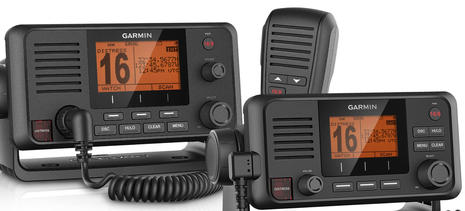 That’s the new $600 VHF 210 AIS left of the $289 VHF 110 radio, both of which await FCC approval before real shipping dates can be set. Both have NMEA 2000 interfaces, which Garmin has made good use of in the past (with smart added emergency call help last year), and I think that they look sharp. But I don’t see any mention of wired or wireless remote mics; I found the previous models a little hard to read, anyway, and, particularly at the 210 AIS price level, the new Standard Horizon GX6000/6500 and also the Icom M506 series both have lots to offer, though with more generic N2K networking.
That’s the new $600 VHF 210 AIS left of the $289 VHF 110 radio, both of which await FCC approval before real shipping dates can be set. Both have NMEA 2000 interfaces, which Garmin has made good use of in the past (with smart added emergency call help last year), and I think that they look sharp. But I don’t see any mention of wired or wireless remote mics; I found the previous models a little hard to read, anyway, and, particularly at the 210 AIS price level, the new Standard Horizon GX6000/6500 and also the Icom M506 series both have lots to offer, though with more generic N2K networking.
And here is Garmin’s new Panoptix PS51-TH multibeam thru-hull transducer, which seems to look a whole lot like the Simrad/B&G ForwardScan I’ve appreciated testing over the last two years. In fact, it fits in the same 2″ Airmar casing and that means that the PS51 now in transit from Kansas should be working in Gizmo very soon. I’m hoping to see better forward looking performance from the Panoptix technology, but there’s also a substantial cost difference with the PS51 at $1,500 and the FowardScan transducer at $699. Game on nonetheless (and here’s hoping this doesn’t trigger more of the confusing patent fighting well covered here by Reagan Haynes).
But do note the PS51 compatability list. It does extend down to Panoptix-enabled fishfinders like the echoMap series, but some older Garmin network MFDs, still otherwise quite useful, did not make the cut. Every major electronics brand has been through platform changes like this, but they are still only good performance and lifetime news for owners on the right side of the change.
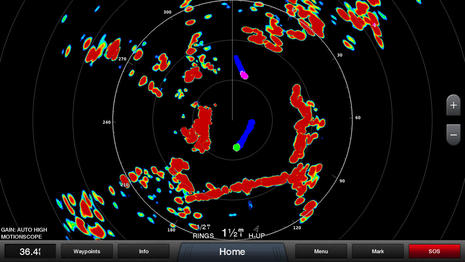 The testing situation is also good for the new GMR Fantom 24 radome and the screen above sets my expectations high. What I like is the mix of true color returns with approaching and going-away moving vessels color coded and usefully echo trailed. Even the $2,600 Furuno DRS4D-NXT Doppler radome that’s so impressed me this season can’t do that, though I notice that the similarly premium $2,800 Fantom 24 doesn’t seem to have anything like the NXT’s Doppler-assisted ARPA capabilities. Then again, the $2,000 Fantom 18 has the same 40 W output as the 24 and the original open array Fantoms I saw demoed in Miami, which bodes well for range.
The testing situation is also good for the new GMR Fantom 24 radome and the screen above sets my expectations high. What I like is the mix of true color returns with approaching and going-away moving vessels color coded and usefully echo trailed. Even the $2,600 Furuno DRS4D-NXT Doppler radome that’s so impressed me this season can’t do that, though I notice that the similarly premium $2,800 Fantom 24 doesn’t seem to have anything like the NXT’s Doppler-assisted ARPA capabilities. Then again, the $2,000 Fantom 18 has the same 40 W output as the 24 and the original open array Fantoms I saw demoed in Miami, which bodes well for range.
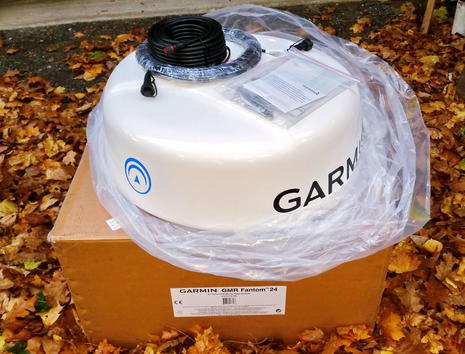 Yes, I’ve got some install work to do, and there is still some fall color up here (and unraked leaves in the driveway). The Fantom 24 arrived yesterday afternoon and I’m fairly sure that I can use the power and data cables already run for the test Garmin xHD 24 currently aboard Gizmo (the test Raymarine Quantum Q24 remains the only radar able to use WiFi instead of Ethernet for the MFD network data connection). In fact, Gizmo may soon sport just four radomes again, but all solid-state. What a difference this year has made.
Yes, I’ve got some install work to do, and there is still some fall color up here (and unraked leaves in the driveway). The Fantom 24 arrived yesterday afternoon and I’m fairly sure that I can use the power and data cables already run for the test Garmin xHD 24 currently aboard Gizmo (the test Raymarine Quantum Q24 remains the only radar able to use WiFi instead of Ethernet for the MFD network data connection). In fact, Gizmo may soon sport just four radomes again, but all solid-state. What a difference this year has made.


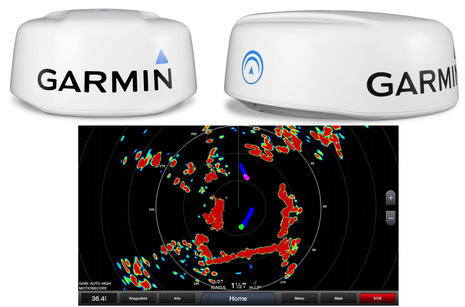
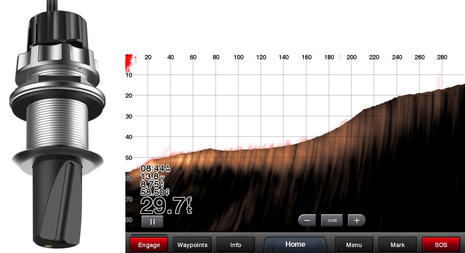
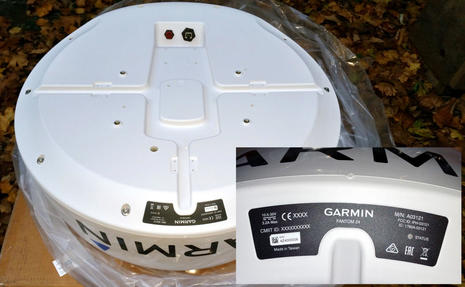

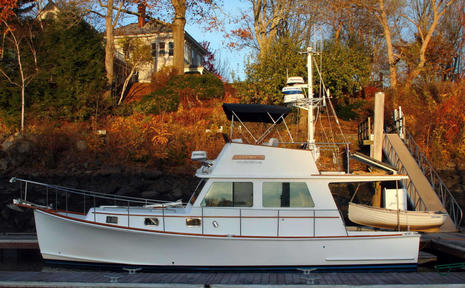
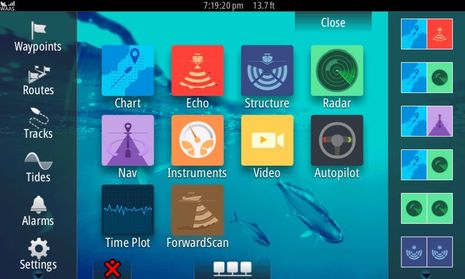
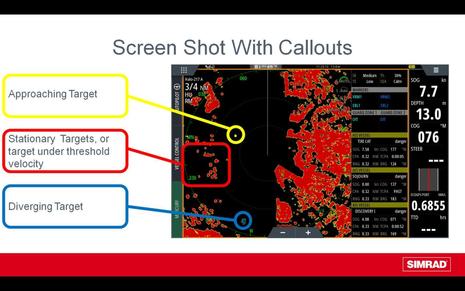








I don’t understand why none of the VHF manufacturers have thought to add the capability to touch an AIS target on your CP and select “DSC Call.” Wouldn’t THAT be convenient – and a fantastic safety feature too!
Hi Ben,
What do you think these displays will be like in sunlight? I have a raymarine es7 on my dinghy. It’s flush mounted and sits about 45 degrees. It’s nearly impossible to see in the sun or with polarized glasses.
I’ve just sold my boat and dinghy (closing in a few hours). I’ve got a new dinghy ordered, but my new big boat has some older Gsrmin 5000 displays. I’ve been a Furuno fan for a long time but the new Gsrmin stuff is impressive. I’m wondering if these new 7″ displays would work with polarized sunglasses and in sunlight. The new dinghy is the same model as the old, a 400 walker bay generations.
If I put Gsrmin on the dinghy, then it would push me to see Stay garmin on the big boat too.
Thanks.
Thanks, Clark. Actually that feature has been around for a while, though limited to certain hardware and apparently not used much. In fact, the first generation of Garmin NMEA 2000 radios can work with Garmin plotters so you can pick an AIS target and set up a direct DSC call on the channel of your choice. Then you only have to push one button on the VHF to put the call through (because they are not allowed to make the routine fully remote controlled).
Here’s some discussion of the Garmin feature with a partial illustration back in 2009…
https://panbo.com/archives/2009/08/garmin_vhf_200_first_impressions.html
…and I’m sure it’s included with the new radios. Simrad/B&G multifunction displays and VHF radios can do similar, Vesper Marine AIS can iniate calls with certain VHF models, and most of the combination VHF and AIS receivers let you pick a target to call off a list.
Apparently it’s possible to do using either NMEA 2000 or 0183 but maybe not in a standard way and certainly not universally. But the big problem, I think, is that many boaters, even professionals on large ships, are not familiar with getting direct DSC calls. They don’t know how to complete the call at their end and the communication fails.
I was hoping that the automation of the calling would help this situation, but haven’t seen evidence yet. What I hear from many AIS users is that they really value the ability to see another vessel’s name and call them that way.
Hi Cameron, I’m a little surprised that you had trouble with the Ray eS7. I have an eS12 on Gizmo’s fly bridge and it seems quite bright. But then again I also have a bimini and all the current LED backlit displays seem very readable.
I do not see brightness specs (like NITS) on the Garmin site, but frankly there don’t seem to be standards that truly measure what the combination of backlighting, contrast, color richness and anti glare coatings really looks like in sunlight. Your best bet might be trying to compare side-by-side displays in dealer show rooms.
You might also consider a different install, like using a bail mount or, better yet, a pod. The angle of the screen relative to the sun seems to make a big difference in extreme situations.
these ‘Budget’ 7″ and 9″ MFDs are about 40% more than comparable Simrad stuff. Same with the radios. I put a GO7 with transducer and a Simrad AIS radio on my fishing boat for $1,400 all-in. The comparable Garmin stuff would have been $2,000 according to the prices you show here.
Love your blog!
Thanks, Andy, but you may be comparing apples to oranges. The prices I quoted are the retail prices listed at Garmin and the Simrad NSS7 evo2 that’s fairly equivalent to the new $1,000 Garmin 742xs lists at Simrad for $1,199:
http://www.simrad-yachting.com/en-US/Products/NSS-Touchscreen-Navigation/simrad-nss7-evo2-en-us.aspx
Of course that’s not the whole story because of all the discounting and bundling that goes on, and I gather that Garmin tends to protect its pricing more. Garmin is also not shy about wanting to be a “premium” brand as in the press release line about the new MFDs that goes “designed for the budget-conscious customer who desires premium features.”
At any rate, the trend is good, I think. I’ve started a spreadsheet on it, but when I refreshed Gizmo’s test fly bridge MFDs this spring the only one that stayed the same was the Simrad NSS16 evo2 and that seemed largely because the other 3 big brands had come out with new models that came close to the value Simrad first offered in the evo2 series. Now rumor has it that Evo3 (or whatever they call it) is on its way.
PS Andy, the GO7 is a great product but not really comparable to the Garmin and Simrad gear discussed above because it can not network with radar, other MFDs, black box sonar etc.
Ben, according to Simrad the go9 will be able to handle all network data, on the “radar” port. They are not going to market that but did it should be well supported. Retail on the go9 with 4g radar and sidescan with chirp is 2600 I believe.
Charles, the GO9 bundle with 4G and transom mount Totalscan looks sweet…
http://www.simrad-yachting.com/en-US/Products/GO-series/Simrad-GO9-XSE-with-TotalScan-and-4G-Radar-en-us.aspx
… but I think it would be a bad idea to expect full Ethernet networking from a product that quite specifically claims only networking between one GO9 MFD and one 3G, 4G or Halo radar. I don’t know what “according to Simrad..” means but the install manual seems quite clear. I see that the GO9 setup menus include all the good NMEA 2000 networking you’d see on an NSS evo2 but the there is zero mention of networking with other MFDs, black box sonar, etc. Instead, there’s just a Radar setup submenu. It’s possible that a GO9 can do networking that’s not documented or promised, but will that be true with next software revision? And how would a customer complain?
hi ben
i was just about to order a 741
for my bristol 34.5.
should i try to wait for the 742 to
ship?
thanks, robie
old 3rd mate aboard regina maris
How are the major brands these days with regards to software crashes on their mfds? A problem? Non issue?
Hi, Robie. I would definitely wait. The 742 will not only have more features and possibilities, and a faster processor etc, but also a much better future in terms of software updates and added options because it uses the newer Garmin platform. And I don’t think the wait will be that long; the days of manufacturers announcing products that don’t actually ship for 6 months or more seem to be over.
By the way, I’ve reminisced a few times here about Regina (what an experience that was), latest here:
https://panbo.com/archives/2013/11/lessons_of_the_bounty_–_andy_nails_it.html
Robert, I can’t say that MFD crashes are a complete non-issue, but I rarely see them and I think I stress systems more than an average boater in terms of N2K networking and button pushing. In my experience, marine electronics continue to get more and more reliable, but perfection has not been attained 😉
Do you expect a transom mount version of the PS51?
I pre-ordered a PS21-TM but this seems to be not state of the art anymore even before it is available.
John, I don’t think there will be transom or trolling motor versions of the PS51 because it is specifically designed to fit in a standard 2-inch ID thru hull casing.
Also, I’m not sure what performance difference there may be between the PS51 and PS21. Both claim 300 feet max range, though the 51 has a much narrower beam width at 20 degrees.
Finally, I have no idea why the PS21-TM is not available while the PS21-TR is. I think the only difference is the bracket.
Yes, availability is a mystery.
One more difference between PS21 and PS51 will be gyro stabilisation. But narrower beam seams most important to me.
Hi Ben,
It seems like Raymarine is being left in the dust w.r.t. Doppler / solid state radar. What does your crystal ball say?
I’ll continue my Garmin MFD boycott unless/until they allow use of Navionics charts…where I boat (Champlain and seldom Ontario), Navionics has the best charting by far, with exclusive access to proprietary bathy data which puts Garmin charts to shame.
I think Garmin has the most intuitive user-interface, but not helpful when it routes you over land, or, when depths are off enough to cause a grounding. Their “not invented here” attitude has cost them a lot of sales, where buyers want access to non-Garmin charts. A non-issue, perhaps, for other areas, but for Great Lakes, Garmin charting sucks.
John Bee, some clarification from Garmin:
“Wanted to quickly clarify a few things coming in on the comments on the Garmin FLIBS post regarding the PS21-TM. After we made that announcement, we determined that we had to redesign the bracket, hence the extreme delay. We’re now on target for Q1 availability. Also, we have the beam shape listed incorrectly on our site; the PS21 and PS51 both have a 20×90 degree beam for LiveVu and FrontVu. The beam can decrease to about 15 degrees, depending on the depth of the water.”
I think that Garmin could also be more clear that the PS51 offers both FrontVu and LiveVu modes. It’s in the specs but not obvious in the marketing materials, and I can confirm that both modes are now available on my test 7612 (though the transducer itself was in a bucket because I have not yet been able to wrestle the ForwardScan transducer out of its casing).
Robert, I don’t know any secrets but I suspect that both Raymarine and Navico are working hard to add Doppler features to the solid-state radar technology they already have. I don’t know when it will come or if it will be backward compatible with existing radars and/or radomes like Quantum, 4G or Halo, but it must be a high priority in their R&D centers.
Meanwhile, I’m realizing that the Doppler-assisted ARPA “Fast Tracking” that Furuno put in the NXT radome is as valuable as the instant target motion highlighting that both NXT and Garmin Fantom have. And I like how Garmin MotionScope highlights targets moving away as well those moving toward you, which Furuno doesn’t.
My guess: eventually all the brands will offer Doppler solid-state radar and the competition will be about how to best use the Doppler capabilities.
I boat in Georgian Bay, and used to do the Trent-Severn waterway yearly. I’ve had Gsrmin, navionics, cmap, and Raster charts on my navnet3’s. I do have a few issues with Garmin charts, namely they don’t label the bays so I sometimes have trouble finding what I’m looking for. As to accuracy, the Gsrmin charts are the only ones that have me in water the entire time through the Trent waterway and their charts seem to match land based on radar overlay best too.
I was a fan of cmap for years, and on my navnets had both cmap and raster, but not navionics. I had issues with navionics on this and an older raymarine e series. One issue was that st certain zoom levels, markers would disappear. Not s big deal, they all do that, but in one case (the south end of Giants Tomb), only some of the markers disappeared and this was right where the markers changed. As a newer boater I was going to run the wrong side of the marker if I hadn’t had a cmap chart next to the navionics that showed both red and green that indicated the change. The fault would have been mine for certain, but my trust was shaken.
Another, completely unforgivable Navionics issue I encountered was open water, o obstructions in well marked areas. To me, that meant the water was safe. Looking st the cmap next to it, there where white/blank sections in some of these places. It’s rare, but happened. I played it safe and called cmap the following week wondering what was wrong with my chart or plotter. The answer was shocking: those white areas are places where there is no chart data, they have no idea what’s there. I verified with Canadian hydrographic services, who makes the official charts and confirmed this. The navionics indicated smooth, safe sailing where the cmap indicated it had no idea. Navionics admitted the issue was due to stitching various charts together from different resolutions.
Having bashed them so far, navionics appears to have come a long way. They listened to my issues, fixed some of them and offered to prove the fixes. I applaud them for this.
I just bought a new boat, losing my trusted old navnet 3d units for farming 5000 units. My first thought was “change immediately!” I looked at Furuno, raymarine, and Gsrmin because I could leverage so,e of the existing investment. Raymarine, a brand I once hated and almost threw an e120 in the lake, has impressed and was the front runner for me. I liked their auto routing to make guides for routes I really already knew but just wanted a line on the screen. I have a raymarine pilot, so that would be cool. Furuno just prices itself out for me a bit. The surprise was that Garmin seemed to be a real contender. When I ecieced an email offering steep discounts on 8212 units ($1300 each), it put me over the edge the Garmin camp. Bought 2 of them. I’ve looked over pretty much every area i boat in with the navionics and Garmin app on my iPad. Both seem equal, maybe the Gsrmin edging it ( it maybe that’s bias because I just bought it). The Garmin is still missing the bay names though. I guess I have to have one complaint left.
Ben,
There was a big cat recently flipped in the Atlantic from a large squal or a tornadic waterspout. Do you think the doppler radar/Fantom units help detect these dangerous winds?
That’s a very interesting question, but hard to test!
Actually, I do suspect that good radar could see a tornadic waterspout, assuming it picks up a fair bit of water, and the Doppler motion detection of Fantom or Furuno NXT should highlight it.
It happens that I know Charles Nethersole, the captain of the Atlantic 55 cat called Leopard that flipped, and I spoke with him this morning. I did not ask about radar, but he did describe the vessel actually lifting a bit — Wizard-of-Oz style — before flipping. Charles is extremely experienced, both generally and with that particular boat, but he’s well aware that they lucked out in certain ways. And I’m so glad they did.
Here’s the best description of what happened I know of so far…
https://www.chriswhitedesigns.com/leopard-capsize
…but I’m hoping that Charlie Doane will eventually detail the loss at WaveTrain (and SailFeed).
Ok so Ben, finally got to try out my theory that the radar port is an Ethernet port. I understand your concern about upgrades etc. But much to my enjoyment the system actually works. I connected a Simrad goSE9 via n2k and Ethernet to a BandG T12, and S2009 already on the boat. With the gose9 came a 4g radar, which was also hooked into the Ethernet. I did not hook up bottom sonar to the gose as we already had the s2009 for bottom. We now have radar and chart on both the gose and the t12, and have sonar on all three! Sorry took a year to find a boat to test it on! We will put the total scan transducer in at the next haul out.
Sound good, Charles, but please clarify where the 4G radar is attached on the Ethernet network. Also, for clarity to other readers the B&G T12 is better known as the original B&G Zeus 12 while the S2009 is a discontinued sonar from Simrad Commercial:
https://www.navico-commercial.com/en-US/Products/Discontinued-Products/Echosounders/S2009-Fish-Finder-en-us.aspx
The GO9 XSE radar port is of course Ethernet, but is limited to radar (and satellite weather in US I think).
It doesn’t matter if the GO9 XSE radar port is connected directly to a radar interface box, to another MFD or a network expander, it will share radar and nothing else. And yes, I’ve tested.
I’d say the easiest way to explain this is that the GO9 XSE is able to ‘read’ and ‘control’ a network radar (which all Navico radars are). Multiple devices can ‘read’ and ‘control’ the same radar, whether multiple GO9s or more capable MFDs (or OpenCPN software with the BR24radar_pi plugin). What the GO9 XSE does not do over Ethernet is share any data from its own sensors (e.g. Sonar) or charts.
Neat that this just came up because it looks like there will soon be a GO12 and a new model GO7 that both support radar:
https://youtu.be/eAW9BkG8Z2s
The new G012 and GO7 MFDs are now up at Simrad…
http://www.simrad-yachting.com/en-US/Products/GO-series/
… and it’s interesting how they specify the Ethernet connection:
“Ethernet: 1 x 5 pin yellow connector x 1 Mbit. Radar and Sirius (USA only) connectivity only (unless unlocked)”
So Abbor and Kees described the limitations correctly (thanks!) but it sounds like there may eventually be an optional software unlock that will allow GO’s to fully network sonar, charts, etc. I know that the Halo doppler feature called Velocity Track will be released very soon as a $500 unlock, so Navico has apparently developed an MFD-based unlock system.
From NSS Evo2 5.0-57.1.207 software release information:
Feature unlock
Additional functionality and features can now be purchased and can be unlocked on the Multifunction Display using the new Feature Unlock menu item under Settings. (This is only visible when a compatible device is connected)